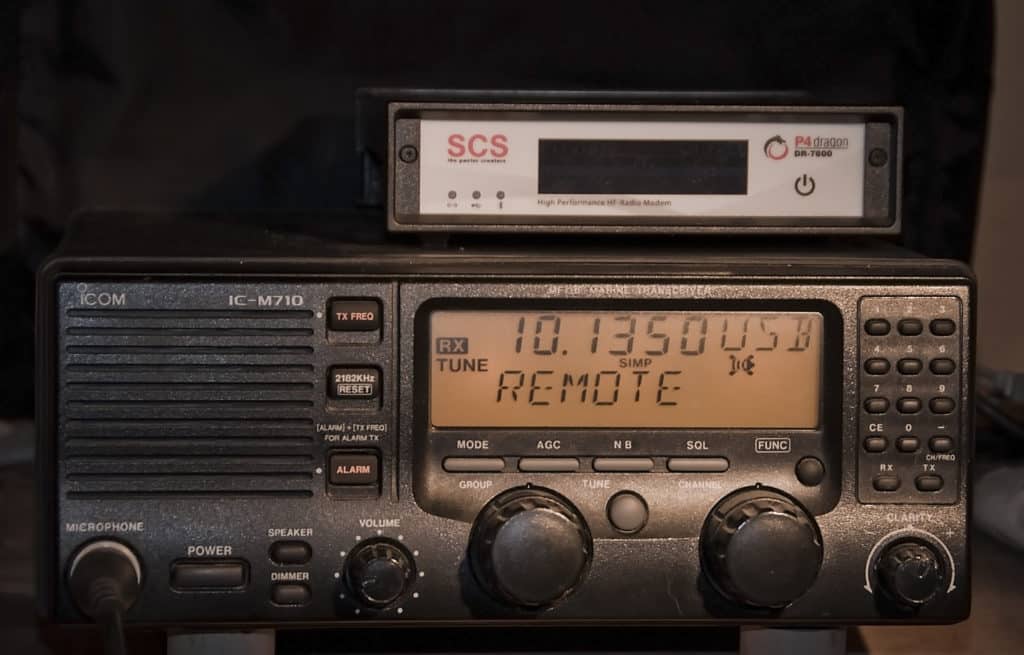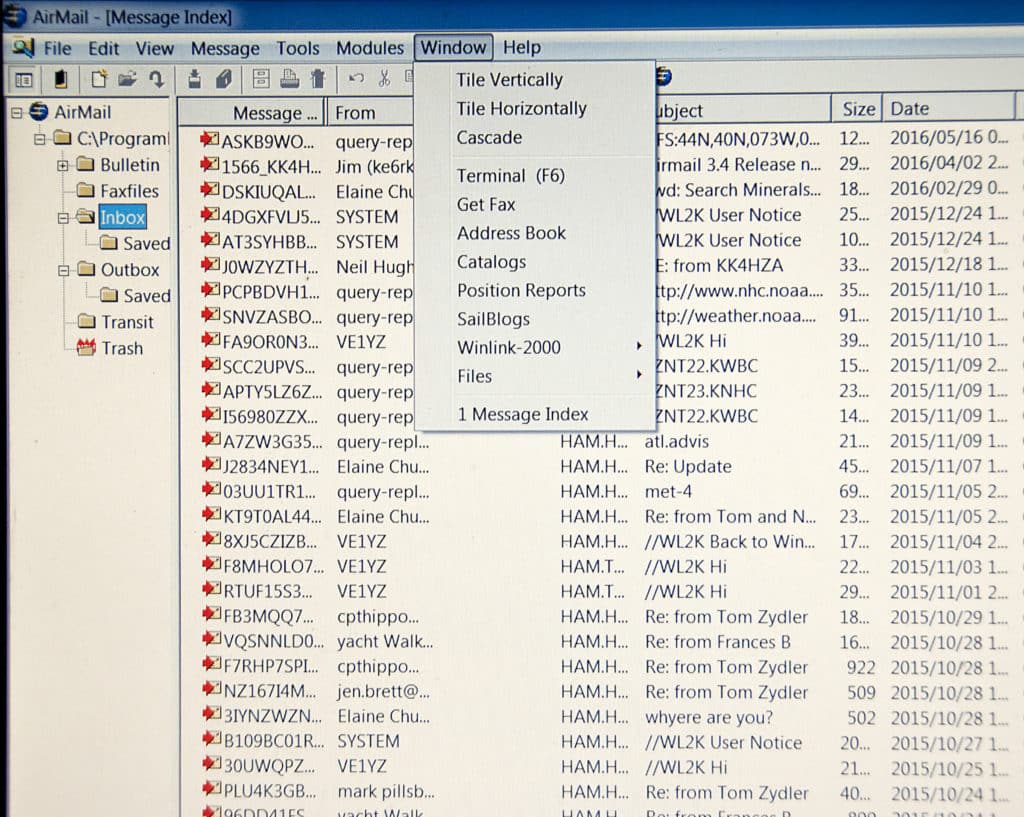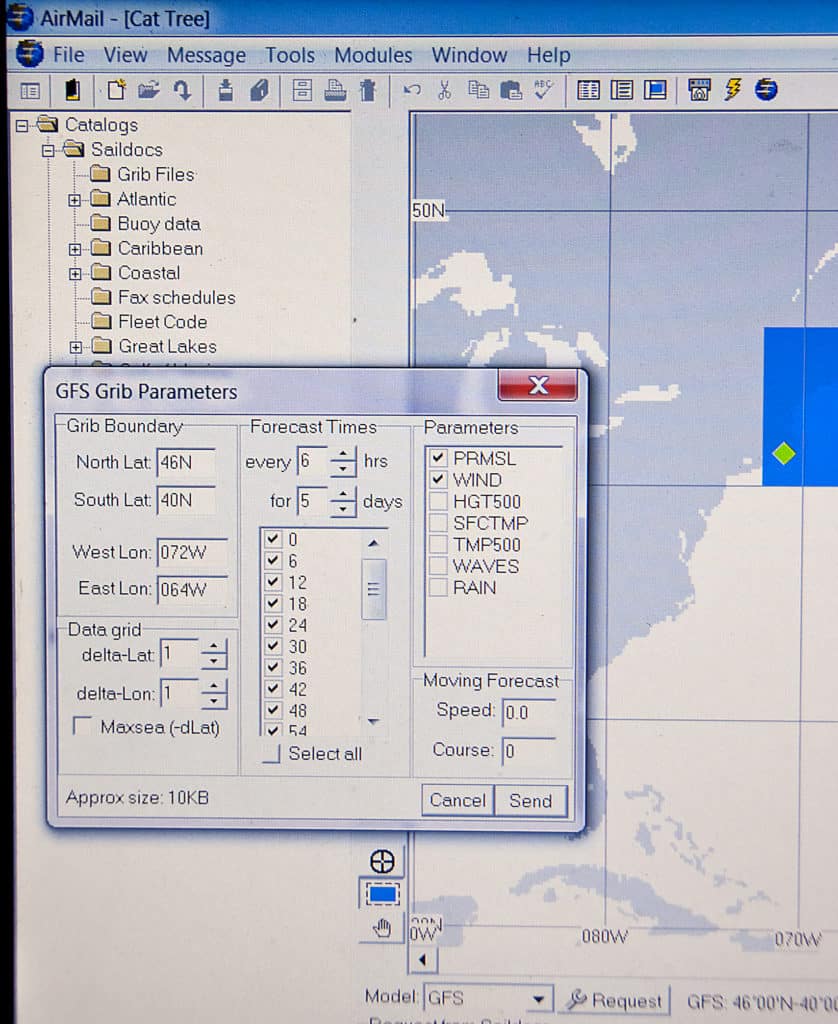
We set sail for blue horizons to get away from it all, shed the pressures of life ashore and stay off the grid. Yet, today, we still can have easy access to instant communications whenever we wish. In many ways, it’s the best of both worlds. One of the easiest methods to connect to the Internet to send and receive email is by using new technology with a relatively old tool — the high-frequency single-sideband radio.
Most bluewater yachts carry an HF/SSB radio. To use one, skippers must obtain a Restricted Radiotelephone Operator Permit issued for the lifetime of the holder by the Federal Communications Commission. They also need a call sign, which is good for 10 years and is also obtained from the FCC. Application forms are available onlinea (wireless.fcc.gov).
To reach the Internet via the popular SailMail (sailmail.com) server, the next step is downloading the free Airmail software onto your computer; the Airmail website (siriuscyber.net/airmail) includes instructions about the nuances of the system. A modem is required to link the SSB and the computer: Pactor 3 or Pactor 4 modems are built in Germany and distributed in the U.S. by Farallon Electronics in Sausalito, California. Its website (farallon.us) not only handles sales, but it also has a wealth of information on installations to get the most efficient radio/modem/computer combination. Contact admin @sailmail.com to register. Subscriptions are $275 per year.
To log on to the Internet without paying fees, a General Class Amateur Radio, or ham, license is required. You can connect to the Internet via the same Airmail/SSB/Pactor modem combination or with a transceiver designed for amateur-radio operations that propagates only on amateur-radio frequencies (commonly known as ham radio). In practice, most yachts will use a standard marine SSB transceiver because it allows voice communications to other vessels, including commercial ships and yachts without licensed ham operators aboard. Ham operators at sea connect to the Internet via the Winlink 2000 network (winlink.org), available only to licensees.
There are important differences between the SailMail and Winlink services. Winlink provides message relays, email with attachments, and graphic and text weather bulletins, but it doesn’t allow the exchange of business-related messages. SailMail users may do business through the service but are limited to 90 minutes a week with messages up to 35 KB long (equal to about 17 typed pages). The only attachments that will go through SailMail are weather GRIB files.

Quite often, amateur radio operators who make a living via Internet messaging will also keep a SailMail account. Using business messaging via SailMail will often cost a lot less than employing satellite servers that charge for every bit of data. Satellite-service customers generally prepay for certain amounts of data, but subscriptions come with a closing date, so the account will shut down even if the user hasn’t utilized all the data paid for.
SailMail and Winlink are quite safe from any kind of spam. For someone to contact you via a Winlink or SailMail address, they first must be in your system. The first time you send an email message to someone, you must put their contact information in your address book. And only after that first email is sent will any communications from them be passed to your account. So, even if someone finds your email address, their messages will not go through unless you have connected with them first, which is probably the safest way in cyberspace to avoid unwanted communications.
After preparing for the test for an amateur radio license via the Internet, once my wife, Nancy, obtained that license (KK4HZA), we gained access to a great many products available to the amateur-radio community. The most important was the ability to receive and send attachments and have access to a much wider choice of weather information and forecasts. And it all came free of extra charges.
Here’s how it works in daily practice. On a typical day, we need to download the forthcoming weather and send some emails to family and friends. To obtain GRIB files — the most convenient graphic presentation of wind direction and atmospheric pressures — we go to the Airmail home page, click the box called “window” and choose “catalogs” from a drop-down menu. On the list that appears, we click “saildocs,” then “GRIB files.” These commands open a world map, so we scroll to the Atlantic Ocean, and then draw the area of interest. Clicking “request” brings a menu where we can choose the number of days we wish to receive this information and in what hour intervals. Clicking “send” puts the request into a mailbox where it’s ready to go.
To write an email, one clicks on a blank-page icon on the home-page toolbar. This drops down the “address book” submenu, where you can either choose an existing recipient or add a new one. Click “OK” and you get a page ready for type. When the message is finished, click the “mailbox” icon on the tool bar, and it’s ready to go out.
To send things, first check that your messages are ready by clicking “outbox” on the left of the home page. Turn on the radio and wait a few minutes for the Pactor modem to stabilize. Meanwhile, you must decide the optimal station to contact. Click F8 on your computer and a propagation table appears. Among other things, it presents a worldwide list of participating amateur-radio stations (also known as RMS).

There are about a hundred of these land-based stations for Winlink and 20 or so for SailMail service. Click on any one and you will see the station’s location and the distance from your boat, as well as the percentage of efficiency of that station’s available frequencies at a given hour (all times are “Zulu,” or GMT). In practice, you will probably have already obtained from other cruisers a list of the best stations for your area. For example, while sailing in western Atlantic waters up to the Canadian Arctic and Greenland, depending on our latitude, we use either KQ4ET in Virginia Beach or VE1YZ in Halifax.
Once you have decided on the station to call, click “modules” on Airmail’s top toolbar. Choose the “HF terminal” and the terminal submenu will appear. Next choose your preferred station and the most efficient frequency for the hour of the day. Listen carefully to see if the radio is free from traffic. If so, click the green button, and the radio will begin transmitting in order to establish a connection. After a successful connection, the outgoing requests go out first. Any incoming messages will be received next. After sending a GRIB file request, the station will disconnect, and the operator on the boat should reconnect again after a few minutes to receive the ready GRIB file package. If the station you first contacted happens to be busy a few minutes later, any other RMS will have the material ready to transmit to you.
How does all this work? The RMS station you reached connects via the Internet to a common message server (CMS), one of five mirror servers scattered on the Internet in strategic locations around the world. CMS servers deal with the requests and outgoing messages, collect any messages addressed to you, and then send them back to the RMS stations. RMS stations then transmit them to your boat’s mobile radio station. Propagation conditions (sun spots, solar flares and the like), as well as the quality of your radio installation, affect the speed of these exchanges between the boat’s SSB radio and the RMS station. Four thousand miles is probably a practical distance limit for good transmissions, though on good nights it can go up to 6,000 miles. At high latitudes, say north of the Arctic Circle, it might be harder to connect quickly; patience and perseverance become great virtues. Also, very active Northern Lights displays will kill SSB communications for short periods.
A good antenna setup is critical. A 40-foot length of backstay with insulators on each end works very well if it has a good counterpoise. An old-fashioned copper ground plate in the water is not necessary. The backstay antenna will go through the deck into an automatic antenna tuner, located somewhere in the stern locker, cabin or lazarette. The ground bolt on the tuner box needs to be connected to a host of metal objects, for example, by several wires attached to the below-deck backing plates of the pushpit legs. Our boat has six of these, and the setup works quite well.
One of the greatest problems is interference from electronic and electrical equipment, alternators, refrigeration compressors, electric pumps, computers, other radios and receivers. All of these can pass unwanted noise into the SSB radio. One can trace the worst culprits by listening to the radio and shutting down pieces of equipment one by one. Ferrite chokes on the wires of offending equipment will help. The interference is more harmful while receiving. Pactor 3 and Pactor 4 modems do their best to adjust the performance. While the radio is connected to an RMS, on the display’s terminal window you can monitor the speed on the bottom line; 200 bits per minute is adequate for short emails but hopeless for receiving anything more complex like a GRIB file. Six hundred bits is OK, 1,400 is quite good and 3,200 is fantastically quick.
A computer loaded with Airmail can be taken ashore and connected via Wi-Fi. You’ll find it lightning-fast. Just click “Internet access” in the Terminals window on the home page. The Telnet window will then drop down (you can also click the yellow lightning icon to get Telnet). Airmail will also work with the Iridium Go! satellite hotspot, cellphone hotspots and so on. Recently, Winlink introduced mandatory password protection, which should make these communications very secure.
This is just an overview of the benefits of connecting to the Internet via SSB radio. Obtaining a ham license extends the list of products enormously. A ham operator can access a tremendous, invaluable list of weather resources from NOAA and the National Weather Service, available only to licensees, by clicking on “catalogs” and “saildocs,” just below “GRIB files.” This enormous package of services is operated by volunteer radio operators. The nonprofit Amateur Radio Safety Foundation administers and monitors SailMail and Winlink operations. Its RMS Express service is often a major contributor of communications in emergency-relief operations during hurricanes, tsunamis and earthquakes.
Tom and Nancy Zydler have spent the past two summers exploring Greenland, Labrador and points north aboard their Mason 44, Frances B.








